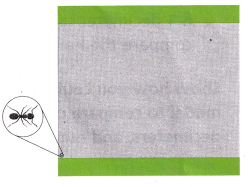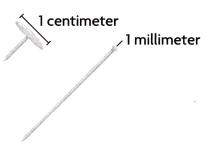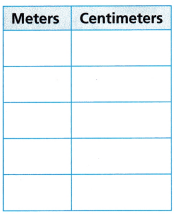We included HMH Into Math Grade 4 Answer Key PDF Module 20 Lesson 2 Compare Metric Units of Length to make students experts in learning maths.
HMH Into Math Grade 4 Module 20 Lesson 2 Answer Key Compare Metric Units of Length
I Can represent and compare measurements given in different metric units of length.
Spark Your Learning
An ant is about 1 centimeter long. This sidewalk square is about 1 meter long. How do these lengths compare?

Show your thinking. Draw a picture to support your answer.
Answer:
Turn and Talk How could you determine the number of ants it would take to equal the length of one sidewalk square?
Answer:
Build Understanding
Question 1.
Ada builds a structure that is 1 meter tall. Her little sister, Diana, builds a structure that is 1 decimeter tall. How could you compare the heights?
Connect to Vocabulary
A decimeter (dm) is a metric unit for measuring length or distance. 10 centimeters are equal to 1 decimeter. 10 decimeters are equal to 1 meter.

Show how you could make a visual model to compare centimeters, decimeters, and meters.
Answer:
A. How does the visual model help you to compare the heights of the structures?
Answer:
B. How would you describe the comparison between the heights of Ada’s and Diana’s structures?
Answer:
Turn and Talk Based on what you know about the comparison between decimeters and meters, how many centimeters are in 1 meter?
Answer:
Step It Out
Question 2.
Now does the width of the heads of 5 thumbtacks set end to end compare to the width of the heads of 55 pins set end to end?

A. Find the width of the heads of 55 pins.
55 pins × 1 millimeter each = ________ millimeters
Answer:
B. Complete the table to find the width of the heads of 5 thumbtacks.

Answer:

Explanation:
We know that 1 centimeters is equal to 10 millimeters.
To calculate the width of the heads of 5 thumbtacks. We need to multiply centimeters with 10 then we get millimeters.
Two centimeters is equal to 20 millimeters.
2 x 10 = 20 mm
Three centimeters is equal to 30 millimeters.
3 x 10 = 30 mm
Four centimeters is equal to 40 millimeters.
4 x 10 = 40 mm
Five centimeters is equal to 50 millimeters.
5 x 10 = 50 mm
The width of the heads of 5 thumbtacks is 50 mm.
C. How do the widths compare?
Answer:
Question 3.
Kelsey walks 2,125 meters. Jacob walks 1\(\frac{1}{2}\) kilometers. Who walks farther?

A. Find the number of meters Jacob walks.
Think of 1\(\frac{1}{2}\) kilometers as 1 kilometer + \(\frac{1}{2}\) kilometer.
_______ meters + _________ meters = ________ meters
Answer:
Kelsey walks 2,125 meters. Jacob walks 1\(\frac{1}{2}\) kilometers.
We know that 1 kilometer is equal to 1,000 meters.
Think 1\(\frac{1}{2}\) kilometers as 1 kilometer + \(\frac{1}{2}\) kilometer.
1,000 meters + 500 meters = 1,500 meters
Jacob walks 1,500 meters.
B. Compare the distances. Who walks farther?
Answer:
Kelsey walks 2,125 meters.
Jacob walks 1,500 meters.
2,125 meters is greater than 1,500 meters.
Kelsey walks farther than Jacob.
Check Understanding
Question 1.
Chandra makes a card that is 2 decimeters long. Can she put it into an envelope that is 23 centimeters long? Explain.
Answer:
Chandra makes a card that is 2 decimeters long.
Convert decimeters into centimeters. We know that 1 decimeter is equal to 10 centimeters.
Multiply 2 with 10 the product is equal to 20 centimeters.
2 x 10 = 20 centimeters
The card is 20 centimeters long. The envelope is 23 centimeters long.
Yes, Chandra can put a card into an envelope that is 23 centimeters long.
On Your Own
Question 2.
Use Structure Colton has a rope that is 5 meters long. Harrison has a rope that is 500 centimeters long. Complete the table.

Answer:

Compare. Use <, >, or =.
5 meters ![]() 500 centimeters
500 centimeters
Answer:
5 meters ![]() 500 centimeters
500 centimeters
Which rope is longer?
Answer:
Colton has a rope that is 5 meters long. Harrison has a rope that is 500 centimeters long. Both ropes are equal in length.
Complete.
Question 3.
200 dm = __________ cm
Answer:
200 dm = 2,000 cm
Explanation:
We know that 1 decimeter is equal to 10 centimeters.
To convert 200 decimeters into centimeters we need to multiply 200 with 10 the product is equal to 2,000 centimeters.
200 dm = 200 x 10 = 2,000 cm
So, 200 decimeters is equal to 2,000 centimeters.
Question 4.
\(\frac{1}{2}\) meter = ________ centimeters
Answer:
We know that 1 meter is equal to 100 centimeters.
So, \(\frac{1}{2}\) meter is equal to 50 centimeters.
Question 5.
7 cm = _______ mm
Answer:
7 cm = 70 mm
Explanation:
We know that 1 centimeter is equal to 10 millimeters.
To convert 7 cm into mm we need to multiply 7 with 10 the product is equal to 70 millimeters
7 cm = 7 x 10 = 70 mm
So, 7 centimeters is equal to 70 millimeters.
Question 6.
9 kilometers = ________ meters
Answer:
9 kilometers = 9,000 meters
Explanation:
We know that 1 kilometer is equal to 1,000 meters.
To convert 9 km into meters we need to multiply 9 with 1,000 the product is equal to 9,000 meters
9 km = 9 x 1,000 = 9,000 meters
So, 9 kilometers is equal to 9,000 meters.
Compare. Use <, >, or =.
Question 7.
19 millimeters ![]() 2 centimeters
2 centimeters
Answer:
19 millimeters ![]() 2 centimeters
2 centimeters
Explanation:
We know that 1 centimeter is equal to 10 millimeters.
To convert 2 cm into mm we need to multiply 2 with 10 the product is equal to 20 millimeters.
2 cm = 2 x 10 = 20 mm
So, 19 millimeters is less than 2 centimeters.
Question 8.
5 decimeters ![]() 51 centimeters
51 centimeters
Answer:
5 decimeters ![]() 51 centimeters
51 centimeters
Explanation:
We know that 1 decimeter is equal to 10 centimeters.
To convert 5 decimeters into centimeters we need to multiply 5 with 10 the product is equal to 50 centimeters.
5 dm = 5 x 10 = 50 cm
So, 5 decimeters is less than 51 centimeters.
Question 9.
9 meters ![]() 900 centimeters
900 centimeters
Answer:
9 meters ![]() 900 centimeters
900 centimeters
Explanation:
We know that 1 meter is equal to 100 centimeters.
To convert 9 meters into centimeters we need to multiply 9 with 100 the product is equal to 900 centimeters.
9 m = 9 x 100 = 900 cm
So, 9 meters is equal to 900 centimeters.
Question 10.
38 millimeters ![]() 3 centimeters
3 centimeters
Answer:
38 millimeters ![]() 3 centimeters
3 centimeters
Explanation:
We know that 1 centimeter is equal to 10 millimeters.
To convert 3 centimeters into millimeters we need to multiply 3 with 10 the product is equal to 30 millimeters.
3 cm = 3 x 10 = 30 mm
So, 38 millimeters is greater than 3 centimeters.
Question 11.
Reason Path A is \(\frac{4}{10}\) kilometer long. Path B is \(\frac{51}{100}\) kilometer long. Trinity hikes both paths. Does she hike at least 1,000 meters? Justify your response.

Answer:
I’m in a Learning Mindset!
How did I feel when I was converting between metric units of length?
Answer: